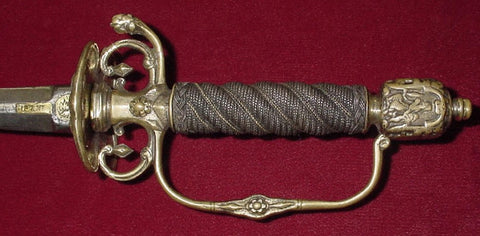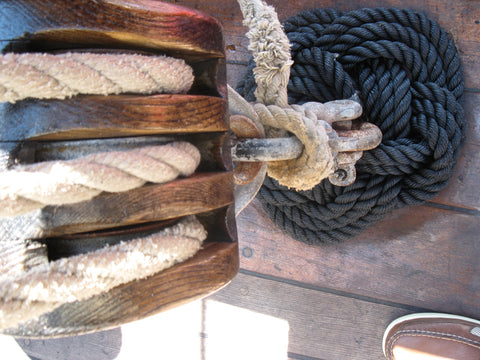Turks Head Knot History
The Turkshead Knot
The turkshead weave somehow connects deep in the human psyche. Throughout history, this balanced circular knot can be seen in pottery, tiles, and functional use. As is the reality of archeology, the soft goods simply don't survive. Most of the work below is representatives of the knots. I tried to find examples that weren't highly stylized and are easily recognized as the classic 1 cord weave that is the turks head, commonly called the sailor knot.
The goal of this article is to explore some images of the Turks Head knot through history, explain some of the uses beyond the ornamental, and just let my knot geek flag fly.

Ok, my adventure started when I read online back in 2013, ‘when a sailor traveled the world, and thought of his love, he’d make one of these bracelets to gift her upon his return.’ This became a joke around our workshop and today I went to find that reference again, and thankfully that bit of tripe is hard to find. It used to be everywhere.
What is a turks head knot?
The Turks Head is a family of knots that is properly defined as a single length of cord wrapped in a continual weave such that the knot is symmetrical in appearance and self locking. It is defined by the number of apparent lines in the weave (leads), the number of scallops down its edge (bights) and the number of times the knot is traced (passes)
The turks head is intended to tighten up on its underlying material to serve as a tubular covering knot to prevent slipping, mark a point, or add a decorative element.
3 lead, 11 bight turkshead 3 pass on left. On the right a 3 part, 2 strand flat sennit weave
What is NOT a turks head knot?
A weave of many strands coming together in a regular pattern that terminates or draws up. If the knot doesn’t lap back on itself and complete a circle, it’s simply not a turkshead. In marlinespike terms, it’s a form of plaiting, not knotting. Rather than call out our competition, our adjustable ankles are 3 strand sennit plait, not a turks head. The clasp gives away the secret. If you see a bracelet with a clasp, it cannot be a turks head.
History of the turks head knot
It’s difficult to find an origin point for a knot as universal in time and space as the turkshead knot. This knot is a self tightening form that can be used to further secure lashings. For that reason, you can find evidence in most cultures for this family of knots. I'll build on this over time, and hopefully put a change log below. I am VERY curious how the iconic sailor knot, the turks head, is represented in different cultures.
I had a choice of listing by age or geography. I think by age would be a little easier to demonstrate the age of these nautical and decorative knots. At the time of this writing, the focus is, unfortunately, on the European continent. Please share links with primary source material when you find resources elsewhere around the globe. I was SHOCKED Shinto and Chinese traditions didn't yield me pictures.. both have a spiritual inclusion of knots in their traditions. Maori also has evidence of the single strand woven knot too, but I'll add them when I find good pictures.
Here we go. Photos by year and place. Links where possible. All pictures are being used for editorial content and commentary. For better resolution and to enjoy the context, please visit their pages and get ready to be lost in the incredible world of knot history.
Fishbourne Roman Palace, created approx 75 A.D.
Roman Way, Fishbourne, West Sussex, PO19 3QR tel: 01243 785859
A three lead turks head is at the top arc of this image from the Fishbourne Roman Palace:

Woodchester in Gloucestershire, England, laid in approx 325 A.D.
Photographed in 1972 by Adrian Pingstone the last time it was shown in 1972. Thankfully released to the p.d. in 2004. This mosaic representation shows a 4 lead turks head knot as part of a 48 foot by 48 foot tile work. Each 'pixel' is a tile about 1/2 inch square. I'll let you do the math on that one.
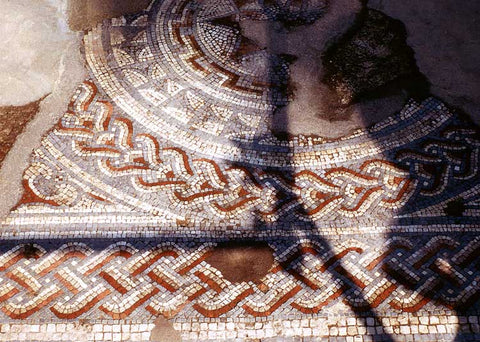
Book of Kells approx 800 A.D.
Below is a low resolution preview of a tiny snippet of folio panel 5R. It shows a 4 lead 1 pass turkshead in the blue field. It took some time to find this example. Check their folio out and try to find some more. The entire treasure is house in Dublin Ireland at Trinity College. They scanned the entire book here. This is one of Europe's most iconic and historic images. There are MANY knots in the illumination, and the work is an absolute masterpiece

Isfahan Pottery 1600's Persia
Persian Pottery from the city Isfahan, 17th century, at the Royal Ontario Museum, Toronto. image by PersianDutchNetwork Isfahan is 210 miles south of Tehran. The outer ring is a turks head knot, 3 passes
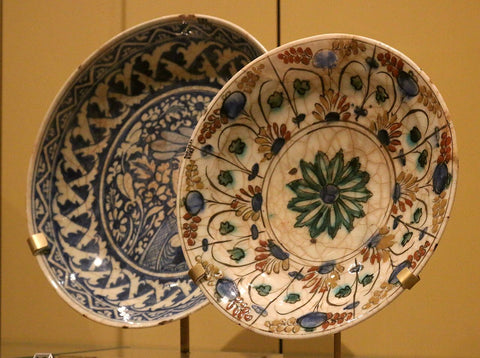
Transitional Rapier / Small Sword late 1600's
This use of a turkshead is incredibly common once you get an eye for it. Dueling era sword handles are hollow, layered with wood or leather and often covered in a wire wrap for grip while wearing leather gloves. While the blade is replaceable with wear and breakage, the hilt is a treasure that carries the 'personality.' The wealth and skill of the swordsman is represented in the hilt. The turkshead is present in a very functional form. At the ends of the spiral wrap, there are sharp ends of wire. The ends could be tacked down or leather wrapped, but doing so will either wear through your glove or the leather covering. The smith quickly realized the turkshead, in the same wire as the wrap, provides the strength to cover the sharp edges and the flexibility to stay put as the handle twists and flexes in use.
This particular model is available at this site and it a German Transitional Rapier stamped with 'Berlin' and it likely from the late 1800's
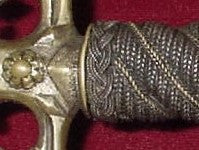
In the Stonington Lighthouse Museum down the street to us is the attached 'bolo whip' that is purported to be from the 1800's indigenous to Australia. I include it as another way the turkshead is involved in that culture as well.
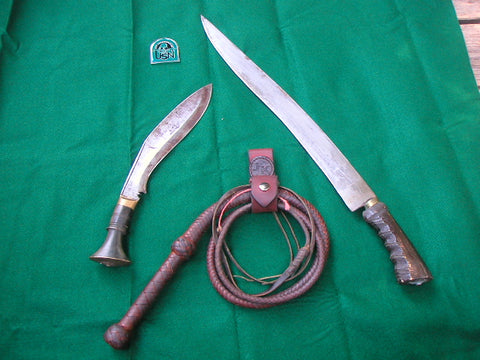
Now we break out to the time we are all familiar with. The age of the tall ship, the age of colonialism, and all that jazz...the search shifts from the internet and libraries to my own computer. Here are some examples of 19th century maritime use of the turks head. Respectfully, two of these pictures were of the Bounty 3 months before she sunk just south of us during tropical storm Sandy.
This is a shot of a turkshead being used as a thump pad at the bottom of a bit of standing rigging.
Also, the turkshead is a decorative knot and here, also aboard the Bounty is a decorative mallet. I left the name plate in the image that I took in July 2012

I'll add more over time, but this brings us up to nearly 1900. The next stage in this article is pictures from my own family history as well as our current shop.
The Turkshead knot is a weave that has been known throughout history and through almost the entire world. This is the surface look at some times and places as a way to examine the role of the turks head weave decoratively and functionally.
Thanks for reading, please email any resources as you find them for possible inclusion.
Thanks
Matt






